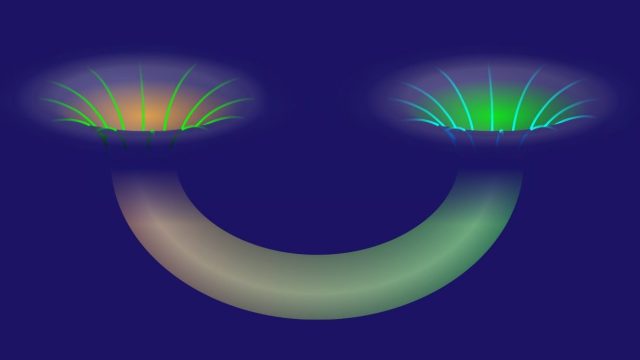|
Big Think
- Posted on Friday December 26, 2025

Perhaps the most remarkable fact about the Universe, if you think about it on a truly fundamental level, is that it exists at all. And yet, not only does it exist, but there’s matter within it, which obeys the same rules everywhere and at all times, and assembles according to the physical laws governing reality to create, among other things:
atomic nuclei,
neutral atoms,
molecules,
stars and planets,
galaxies,
and a large-scale cosmic web.
Not only that, but in at least one relatively unremarkable corner of this Universe, a planet arose some 4.5 billion years ago where life survived and thrived, eventually giving rise to an intelligent, self-aware species that can ask deep questions about the Universe they inhabit.
In doing so, we’re also asking fundamental, deep questions about our own selves, as we’re just as much a part of this Universe as any inanimate objects that exist. That’s what led Steve Cordon to write in and ask one of the deepest questions of all:
“I’ve always wondered why is there something instead of nothing? I’ve read some books authored by a variety of cosmologists. I was curious as to ... Continue Reading » - Posted on Thursday December 25, 2025

With the year winding down and my inbox now filled with out-of-office replies, I thought this week’s Nightcrawler was a good excuse to recommend a couple of feature-length documentaries.
The first is The Thinking Game (free on YouTube) — a five-year portrait of Demis Hassabis, co-founder of DeepMind. On one level, it’s a fascinating account of how a small group of researchers pushed the limits of artificial intelligence and produced genuine breakthroughs.
Beneath the surface, the film is really about long-term thinking. AI can feel like it appeared out of nowhere sometime around 2022. This documentary shows how misleading that impression is. The real story began much earlier — with years of false starts, doubt, and incremental advances that rarely made headlines. When DeepMind’s breakthroughs finally arrive, they are the result of a few individuals who refused to abandon a problem that had defeated scientists for half a century.
Key quote: “My view is that the approach to building technology, which is embodied by move fast and break things, is exactly what we should not be doing. Because you can’t afford to break ... Continue Reading » - Posted on Thursday December 25, 2025

What would be a good gift to buy a philosopher? A few weeks ago, I asked 10,000 people this question and got thousands of replies back.
Some, of course, were funny: “A job,” “Some money,” and a “girlfriend.”
Some were predictably context-appropriate: “An unanswerable question,” “Time to think,” and “A deep conversation.”
Others were oddly mundane: “Socks,” “A mug,” or a “book.” When Diego said “a comb,” I think he was getting personal. (You can find the best of the rest over on Substack.)
But there was one answer that really got me thinking. I am sure it was meant as a joke, but you have to be careful joking with the philosophically minded. Because quite a few people said “purpose” or “meaning.”
I started to imagine the scene:
My son runs over with a gilded, vibrating, and immaculately wrapped box.
“Open it, daddy!” he says, with the saccharine cliché of a Hallmark movie.
And so, I do. I pull at the ribbon, open the box, and peek inside. There, like some glowing magic from the end of Pulp Fiction, is PURPOSE. I stare straight at the meaning ... Continue Reading » - Posted on Thursday December 25, 2025

If there’s one thing most of us can be certain of it’s this: that our observed, physical reality actually exists. Although there are always some philosophical assumptions behind this conclusion, it’s an assumption that isn’t contradicted by anything we’ve ever measured under any conditions: not with human senses, not with laboratory equipment, not with telescopes or observatories, not under the influence of nature alone nor with specific human intervention. Reality exists, and our scientific description of that reality came about precisely because those measurements, conducted anywhere or at any time, are consistent with that very description of reality itself.
But there had previously been a set of assumptions that came along with our notion of reality that are no longer universally agreed upon, and chief among them is that reality itself exists in a fashion that’s independent of the observer or measurer. In fact, two of the greatest advances of 20th century science — relativity and quantum mechanics — specifically challenge our notion of objective reality, and rather point to a reality that cannot be disentangled from the act of observing ... Continue Reading » - Posted on Wednesday December 24, 2025

Imagine there’s a large, flat sheet of ice out in front of you, and someone unceremoniously shoves you across it at a high speed. What are you to do? If you’re wearing conventional shoes, without crampons or blades attached to them, you’re going to have a difficult time. Ice is a very low-friction surface, and there’s very little you’re going to be able to do to change your momentum without slipping and perhaps falling down. You’re bound to simply slide along until either you run into an obstacle or slowly come to rest, likely a long way from where you began.
But if you put thin blades on the bottoms of your shoes — e.g., wear ice skates — you’ll discover that the situation is very much different in this case. As long as you can remain on your feet, with only your blades touching the ice, you’ll find that you can control your motion relatively easily, simply by applying forces through your feet (and the blades) to the ice down below. You can speed up, slow down, or change direction ... Continue Reading » - Posted on Tuesday December 23, 2025

As 2025 comes to a close, I’ve been reflecting on what it means to practice leadership while helping others develop it. I’m Charlotte Sharpe, Managing Director of Research and Innovation at Big Think+. My role is to drive alignment between our content and platform, ensuring that what we build, design, and deliver truly serves our clients—organizations that are bringing leadership development to life within their own cultures.
Across this year, our team’s work has revolved around three ideas: clarity, collaboration, and storytelling. Together, they’ve shaped how we scale leadership: both inside Big Think+ and across the organizations we partner with.
1. Clarity Scales
One of our most important realizations this year is that clarity is a form of leadership. The ability to define what we mean, decide what matters, and move forward even when information is incomplete has been essential to every major milestone we reached.
In her Big Think+ lesson “Systematic Strategies for Making Hard Calls,” Suzy Welch reminds us that decisiveness is ... Continue Reading » - Posted on Tuesday December 23, 2025
We’ve grown comfortable with the idea that trauma leaves people permanently altered. It’s a compelling story, but a misleading one.
Drawing on more than a hundred studies, clinical psychologist George Bonanno explains why resilience is not a rare trait or a heroic exception, but the most common human response to adversity.
This video The real reason some people adapt faster than others is featured on Big Think.
Continue Reading » - Posted on Tuesday December 23, 2025

Despite these times of extreme change, uncertainty, and complexity, many leaders still expect that they, and the people who work for them, should leave their worries at the proverbial office door. If that ever was a reasonable expectation, however, it clearly no longer is.
Across industries and at all levels, people are overwhelmed, exhausted, and burning out like never before. The consequence: ever-growing disengagement, which undermines individual well-being and organizational productivity and performance.
In its most recent State of the Global Workplace report, Gallup found that the percentage of engaged employees dropped from 23% to a meagre 21% last year — a decline equal to that seen during COVID-19 lockdowns.
There are many contributors to this. Friction around return-to-work orders. Increasing financial stressors and polarization. The rise of AI.
And there is yet another big one that fails to get the attention or response it deserves. As the authors of another Gallup report, The State of the World’s Emotional Health 2025, succinctly put it, “The world is on an emotional edge.”
Have you ever spent most of your day worrying? It turns out, 39% ... Continue Reading » - Posted on Tuesday December 23, 2025

Earth, whether we like it or not, serves as a cosmic particle detector on a continuous basis. It isn’t just light waves that travel through the Universe, nor is that light merely joined by gravitational waves and ghostly neutrinos. In truth, cosmic particles and antiparticles of all types are produced in high-energy processes throughout the Universe, from the Big Bang to stars to white dwarfs to neutron stars to black holes, both large and small. When we put detectors up to detect what sorts of particles are out there, we find a virtual zoo, including:
protons,
antiprotons,
electrons,
positrons,
and even still-heavier atomic nuclei, made out of protons and neutrons combined.
Most cosmic rays, as we measure them, turn out to be protons, and just as you’d expect, there are more of them at lower energies and fewer and fewer of them as you look to ever-higher energies. However, there’s a theoretical limit to how energetic even the highest-energy cosmic rays ought to be: about 50 exa-electron-volts (50 EeV, or 5 × 1019 electron-volts), a limit known as the GZK cutoff. In 1991, the Fly’s Eye ... Continue Reading » - Posted on Monday December 22, 2025

Philosophers and scientists have always kept close company. Look back far enough, and it’s hard to tell where one ends and the other begins.
Before we had instruments to measure reality, we had to reason our way into it, but that intellectual lineage is what eventually gave us the scientific method. As technology advanced and the scope for observation expanded, specializations splintered off from philosophy to reconstitute as the sciences.
Astronomy cleared the sky of deities and showed us a universe governed by gravity, not gods. Geography mapped a not-so-flat Earth, then geology dated it, stratifying earthly time in isotopes and sedimentary layers. Physics folded time into space, and with it, reimagined us not as beings apart from nature, but as a continuation of its energy and mass. We are not, as Pink Floyd suggested, “lost souls swimming in a fishbowl.” We are matter, muddling our way through life in relativistic motion.
Now, in the 21st century, science is tracing a map through the other great unknown: the mind.
Advances in biophotonics and neuroimaging have brought us closer than ever to a material picture ... Continue Reading »
|

